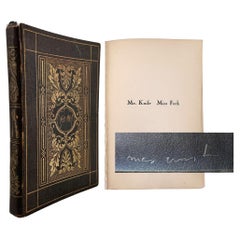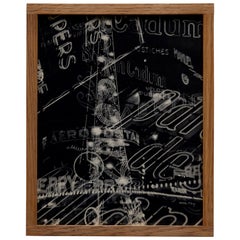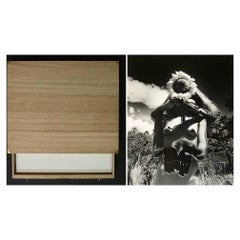Man Ray Rayograph
Mr. Knife Miss Fork by R. Crevel - Surrealist illustrations by MAX ERNST
Located in Middletown, NY
produced using a similar process to Man Ray's rayographs. Ernst's images were made by combining rubbings
Category
Early 20th Century English Books
Materials
Gold Leaf
$12,500
H 7.01 in W 4.45 in D 0.6 in
Recent Sales
Man Ray Electricite Black and White Rayograph, 1931
By Man Ray
Located in Barcelona, Barcelona
Rayograph Héliogravure by Man Ray for Compagnie Parisienne de Distribution d'Electricité, 1931
Category
Vintage 1930s French Mid-Century Modern Prints
Materials
Paper
Eikoh Hosoe: Before the Dawn Portfolio, 10 Signed Silver Gelatin Prints, 9 of 10
Located in Hillsborough, NJ
: Solarization (in the style of Man Ray's Rayograph), photograms (in the style of Moholy Nagy), and photo
Category
1990s Japanese Books
Materials
Paper
H 12 in W 10 in D 4 in
Rayograph 1922, Man Ray
By Man Ray
Located in bari, IT
Rayograph
A term invented by Man Ray, in which he merged his name with the word “photograph” to
Category
Vintage 1920s German Photography
Materials
Wood, Paper
Man Ray Electricite Rayograph, 1931
By Man Ray
Located in Barcelona, Barcelona
Rayograph Héliogravure by Man Ray for Compagnie Parisienne de Distribution d'Electricité, 1931
Category
Vintage 1930s French Mid-Century Modern Prints
Materials
Paper
People Also Browsed
George IV Gilt Sugar Bowl
By Benjamin Smith
Located in New Orleans, LA
This exquisite George IV period silver sugar bowl by the celebrated Benjamin Smith is crafted in an exuberant Rococo style. From the floral and foliate handles to the delicately engr...
Category
Antique 19th Century English Rococo Sterling Silver
Materials
Sterling Silver
Bessarabian Rug, 1810
Located in New York, NY
Bessarabian rug, 1810
Russia, circa 1810
Tapestry woven carpet
Imperial Tapestry Factory, St. Petersburg
Having an Adamesque central medallion on a warm caramel ground, with swan...
Category
Antique Early 19th Century Russian Russian and Scandinavian Rugs
Materials
Wool
Antique German Toy Glass Marble Set 1910-1920s, in Original Leather Pouch
By Lauschaer
Located in Andernach, DE
Early 20th century glass marble set from Lauscha in their original hand crafted genuine leather pouch.
A true German classic, exported worldwide, also to the US.
The invention of the...
Category
Vintage 1910s Japanese Mid-Century Modern Toys and Dolls
Materials
Leather, Glass
$329 / set
H 1.5 in Dm 1.5 in
"Under the Canopy" Butterfly Dome by Hasharat
Located in New York, NY
Under the Canopy: This exquisite composition seamlessly blends insect preservation with contemporary artistry, featuring an array of real butterflies meticulously arranged by Hashara...
Category
21st Century and Contemporary American Taxidermy
Materials
Glass, Wood
The Old Man and the Sea by Ernest Hemingway, First Edition, 1952
By Ernest Hemingway
Located in Colorado Springs, CO
Hemingway, Ernest, The Old Man and the Sea. 1952, New York: Charles Scribner's Sons. First Edition. Rebound in blue Morocco leather with custom embossed stamp on the front, raised ba...
Category
Vintage 1950s American Mid-Century Modern Books
Materials
Leather, Fabric, Paper
Victorian Marquetry Tip-Top Center Table Attributed to Edward Holmes Baldock
By Edward Holmes Baldock
Located in Los Angeles, CA
An extraordinary fine English victorian marquetry Sycamore, Amboyna, burr-walnut and ormolu-mounted circular tulipwood crossbanding tip-top center table with inlaid decorations depic...
Category
Antique 19th Century English Victorian Center Tables
Materials
Bronze
$124,500
H 29.25 in W 53.5 in D 53.5 in
Durgin Wentworth Flatware Service, 167 Pieces
By William B. Durgin
Located in New Orleans, LA
This rare 167-piece Wentworth sterling silver flatware service was crafted by the celebrated William B. Durgin Silver Company. Each piece bears an intricate, hand-chased pattern feat...
Category
20th Century American Other Tableware
Materials
Sterling Silver
1 Vol. Dante Alighieri, The Vision: or Hell, Purgatory, and Paradise
Located in New York, NY
1 Vol. Dante Alighieri, The Vision: or Hell, Purgatory, and Paradise (with a Life of Dante). The Albion Edition. Translated by Henry Francis Cary. Vellum bound, Vellucent Binding. Co...
Category
Antique 19th Century English Books
Materials
Leather
$2,500
H 8.25 in W 5.875 in D 2 in
DICKENS. A Christmas Carol. 1843 - FIRST EDITION FIRST ISSUE - IN ORIGINAL CLOTH
Located in Hillsborough, NJ
AUTHOR: DICKENS, Charles.
TITLE: A Christmas Carol In Prose Being A Ghost Story of Christmas.
PUBLISHER: London: Chapman and Hall, 1843.
DESCRIPTION: FIRST EDITION FIRST ISSUE. 1...
Category
Antique 1840s British Books
Materials
Fabric
$24,000
H 6.63 in W 4.38 in D 0.5 in
Heroes of the Plains by J. W. Buel, Illustrated, circa 1880s
Located in Colorado Springs, CO
Buel, James W. Heroes of the Plains, or Lives and Wonderful Adventures of Wild Bill, Buffalo Bill, Kit Carson, Capt. Payne, “White Beaver,” Capt. Jack, Texas Jack, California Joe, an...
Category
Antique 1880s American Late Victorian Books
Materials
Fabric, Paper
MILNE, A. A.. Winnie The Pooh. IN A FINE EXTRA GILT BINDING !
Located in Hillsborough, NJ
AUTHOR: MILNE, A. A.
TITLE: Winnie The Pooh.
PUBLISHER: London: Methuen & Co. Ltd., 1967.
DESCRIPTION: 1 vol., 7-1/4" x 5", illustrated by E. H. Shephard. Bound in full polished ...
Category
Vintage 1960s British Books
Materials
Leather
Oregon Trail: Sketches of Prairie and Rocky-Mountain Life by Francis Parkman
By Francis Parkman, Frederic Remington
Located in Colorado Springs, CO
Parkman, Francis. The Oregon Trail: Sketches of Prairie and Rocky-Mountain Life. Illustrated by Frederic Remington. Boston: Little, Brown, and Company, 1894. Octavo. Rebound by Benne...
Category
Antique 1890s American Books
Materials
Leather, Paper
$650
H 8.13 in W 5.63 in D 1.88 in
A. A. MILNE. Toad Of Toad Hall. 1929 - FIRST DELUXE EDITION - SIGNED
Located in Hillsborough, NJ
AUTHOR: MILNE, A. A. (Alan Alexander).
TITLE: Toad Of Toad Hall. A Play From Kenneth Grahame's "The Wind In The Willows".
PUBLISHER: London: Methuen & Co. Ltd., 1929.
DESCRIPTION...
Category
Vintage 1920s British Books
Materials
Fabric
$4,950 / item
H 9.13 in W 7.38 in D 1 in
Large Berlin KPM Porcelain Plaque, "The Dancing Lesson of Our Grandmother"
By K.P.M. Berlin
Located in Tarzana, CA
"The Dancing Lesson of Our Grandmother" (The Dance Lesson). Considered by collectors and dealers to be one of the best and most desirable K.P.M plaques ever produced, this magnificen...
Category
Antique 19th Century German Ceramics
Materials
Wood, Porcelain
$152,000
H 22.75 in W 30.75 in D 2 in
Quality Street by J. M. Barri - FIRST EDITION, DELUXE, illustr. by Hugh Thompson
Located in Middletown, NY
London: Hodder and Stoughton, 1913.
Illustrated by Hugh Thompson. First, Limited Edition.
4to, Deluxe Edition, 12 1/4 x 9 1/2 inches (312 x 242 mm); pp. viii + 198 + 2. Twenty-two ...
Category
Early 20th Century American Books
Materials
Gold Leaf
$1,000
H 12.29 in W 9.53 in D 2.37 in
Artistic Inlaid Polychrome Backgammon Set by Fabio Calagna by RARO MILANO
By Raro Milano
Located in Milan, IT
Boasting a luxurious and intricate artisan design, this backgammon set elevates entertainment to new levels of exclusivity. A precious inlay combining blue and beige birch with black...
Category
2010s Italian Games
Materials
Wood
$30,383 / item
H 1.58 in W 29.53 in D 23.63 in
Get Updated with New Arrivals
Save "Man Ray Rayograph", and we’ll notify you when there are new listings in this category.
Man Ray Rayograph For Sale on 1stDibs
Choose from an assortment of styles, material and more with respect to the man ray rayograph you’re looking for at 1stDibs. Frequently made of paper and wood, every man ray rayograph was constructed with great care. There are many kinds of the man ray rayograph you’re looking for, from those produced as long ago as the 20th Century to those made as recently as the 20th Century. Each man ray rayograph bearing mid-century modern hallmarks is very popular.
How Much is a Man Ray Rayograph?
Prices for an man ray rayograph can differ depending upon size, time period and other attributes — at 1stDibs, they begin at $200 and can go as high as $35,111, while the average can fetch as much as $6,600.
More Ways To Browse
Rene Crevel
Max Ernst Gold
Sheffield Plate Entree Dishes
Shepherd Statue
Shigaraki Tsubo
Ship Mermaid
Shoe Snuff Box
Shot Glass French
Signed David Cressey
Signed Ginger Jars
Silver Antique Cream Pitchers
Silver Bridal Basket
Silver Christening Cup
Silver Christening Set
Silver Cocktail Sticks
Silver Duck Decanter
Silver Holy Water Font
Silver Hunt Cups


